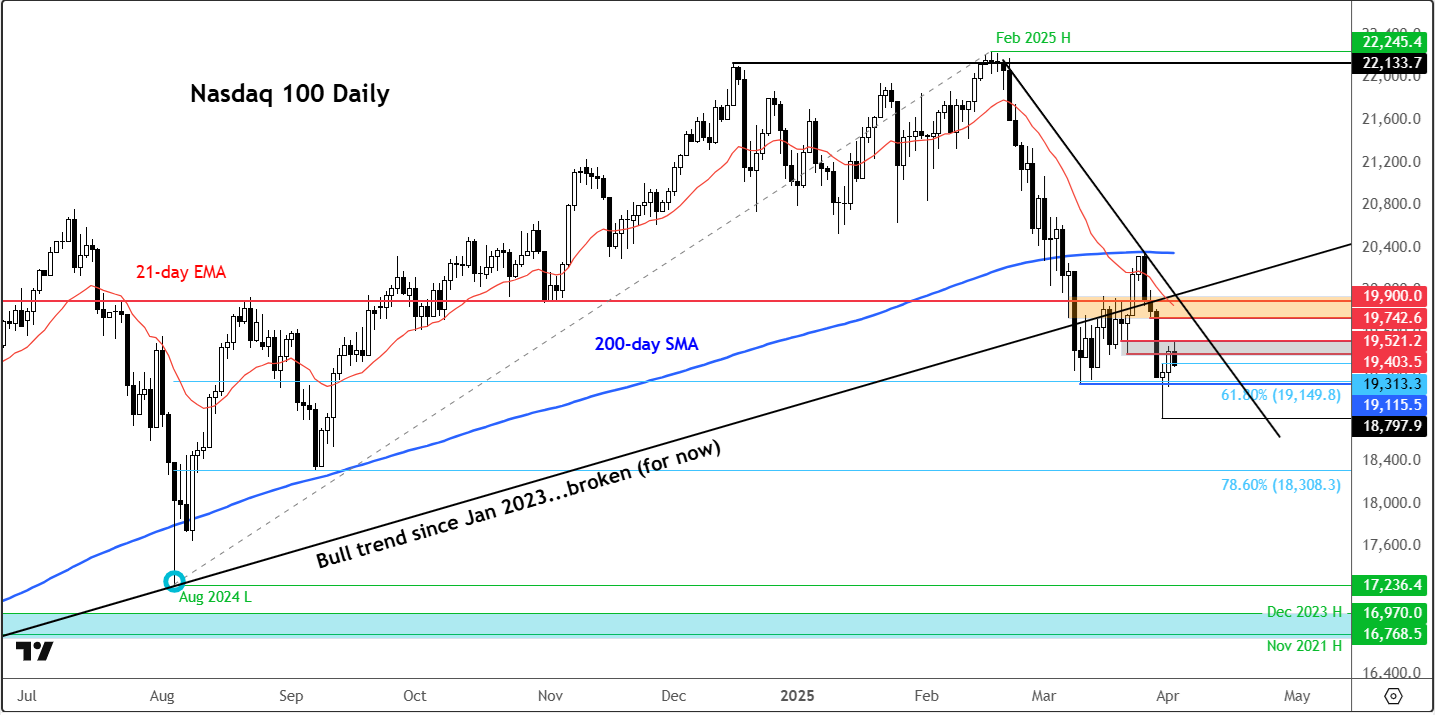- As “Liberation Day” tariffs land, markets brace for impact.
- The Nasdaq’s bounce may already be running on fumes.
- With stagflation fears rising, the bulls need more than hope to hold the line.
- Looking for more actionable trade ideas to navigate the current market volatility? Subscribe here to unlock access to ProPicks AI winners.
European markets and US index futures resumed lower as the trade war enters a critical phase: Trump’s reciprocal tariffs day finally arrives. The weakness comes after tech shares gave US indices a decent boost at the start of this week from oversold levels. However, with risk sentiment remaining fragile following a bruising last few weeks, and before Donald Trump’s highly anticipated tariff announcement later, it was always going to difficult for the bulls to justify holding onto the gains for too long. With the exact scope of these measures still uncertain, you can understand why investors remain cautious, reluctant to take on greater exposure to riskier assets just yet.
Will the Selling Gather Pace Again?
While markets were firmer at the start of the week, it could be a totally different story today, and judging by weakness in index futures, it could well turn out to be a red session – barring a surprise from Trump. The trend on US indices has been quite bearish lately and on the day of Trump’s announcement of tariffs, traders will be unwilling to take on too much risk, you’d imagine. Last week’s sell-off was particularly brutal for Wall Street, with technology stocks bearing the brunt of investor unease. The S&P 500 fell another 2% on Friday following the announcement of new levies on imported vehicles. Volatility carried into Monday, as early losses gave way to a late-session rebound, softening the blow, before markets rose a little further on Tuesday. But was the calm before the storm: further downside could be in store for stocks if Trump opts for tough tariffs.
"Liberation Day" Tariffs Ahead
Now, all eyes are on Trump’s next move: a sweeping new set of tariffs set to be unveiled later today, an occasion he has proudly dubbed "Liberation Day." Trump hopes that higher tariffs will fuel domestic industry and create jobs, and boost stock market. But so far, the stock markets have not responded how he had hoped. Investors fear tariffs could stoke inflation while simultaneously dragging on economic growth—a toxic combination for an already fragile market.
It is not just uncertainty about Trump’s latest measures, but also retaliatory measures from affected nations which could inject further volatility into financial markets, exacerbating uncertainty.
Trump’s so-called "reciprocal tariffs" are intended to counteract foreign levies on US exports. The White House insists these measures will "level the playing field," but critics warn they could provoke retaliation, suppress global trade, and ultimately impede economic growth.
These new tariffs will follow earlier duties on steel, aluminium, and imports from China, Mexico, and Canada. This latest round is expected to target nations with substantial trade surpluses against the US, with tariffs ranging from 10% to as high as 50% on hundreds of products.
The European Union and Canada remain firmly in Trump’s sights, with additional tariffs threatened should their economic policies be deemed unfavourable to US interests.
With uncertainty mounting, one thing is clear: market volatility is here to stay, and the Nasdaq 100 direction remains clouded by the unpredictable nature of trade policies and economic headwinds. The coming weeks will be pivotal in shaping the next phase of market direction.
Stagflation Concerns Remain in Place
Curiously, the US dollar index failed to rally last week and remained largely out of favour so far this week, as investors have pivoted towards gold and the yen. The shift signals growing concerns over the resilience of the US economy, exacerbated by Donald Trump’s increasingly protectionist policies.
Meanwhile, economic concerns were highlighted again as fresh data pointed to a weakening US economy, yesterday. Not only did the ISM Manufacturing PMI come in weaker (at 49.0 compared 50.3 expected) we also had a softer JOLTS Job Openings print (7.57 million vs. 7.69 million expected).
The latest data follows last week’s mixed bag calendar. Strong figures in Durable Goods Orders, the final Q4 GDP estimate, and Pending Home Sales offered some encouragement last week. However, softer readings in New Home Sales, Consumer Confidence, and Manufacturing PMI paint a more concerning picture. It was Friday’s Core PCE index—the Federal Reserve’s preferred inflation gauge—that truly rattled investors, as it came in higher. Adding to concerns, the University of Michigan’s inflation expectations survey surged to 5.0%. With Trump’s tariffs yet to fully filter through economic data, Fed Chair Jerome Powell’s assurances that inflation remains contained will face a stern test in the weeks ahead.
The Nasdaq 100, which has ridden high on the artificial intelligence boom, is now finding itself struggling to rise. Like the broader market, the index is contending with the twin headwinds of slowing growth and rising inflation. Should economic data continue to falter, markets may begin pricing in a Federal Reserve rate cut sooner than currently anticipated.
Key Data: Non-Farm Payrolls
Once the latest tariffs are announced this week, attention will then shift to retaliatory measures. But from a data point of view, the March non-farm payrolls report on Friday could also trigger some volatility. February’s employment data was underwhelming, with just 151K jobs added versus expectations of 160K. More troublingly, the household survey indicated a sharp decline of 588K jobs, nudging the unemployment rate up to 4.1% from 4.0%. With leading survey data already deteriorating, another weak print could amplify recession fears and increase pressure on the Fed to adopt a more dovish stance. Additional key data releases this week include ISM services PMI on Thursday, and ADP private payrolls today – not that anyone will care about the latter much.
Nasdaq 100 Trade Ideas and Key Levels to Watch
Following an oversold bounce at the start of the week, the Nasdaq 100 is now finding in the 19400-19520 range, an area marked in grey on the chart. This zone was old support and with the trend being bearish, it is now acting as resistance. Above this zone, the next critical resistance area to watch is around 19740-19900, where prior support and resistance meets the intersection of a short-term bear trend with the underside of the broken long-term trend. Only if and when we go above this area on a daily closing basis will we have a solid bullish reversal formation to work with.
Meanwhile, short-term support levels to watch include Monday’s high of 19313, when the index formed a hammer candle. This level was being tested at the time of writing. The index needs to hold above this level on a daily closing basis to maintain bullish hopes alive that the short-term bias has tilted to the bulls’ favour following Monday’s the fake out below the prior low of 19115. But in the likely event we go back below it, and stay below it, then that would put the bulls who bought this latest drop, in a spot of bother. Their stops will be resting below yesterday’s low of 19090 and some below Monday’s low of 18797. Those are the next downside targets in the near-term.
******
